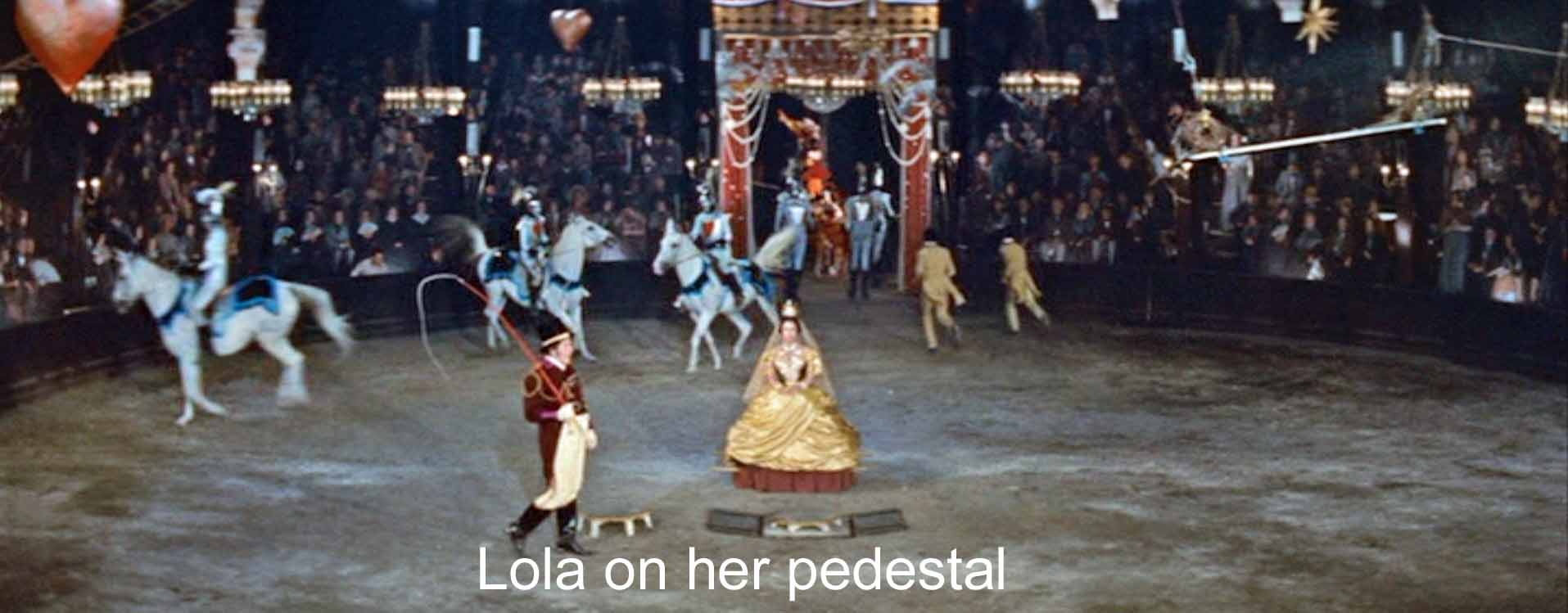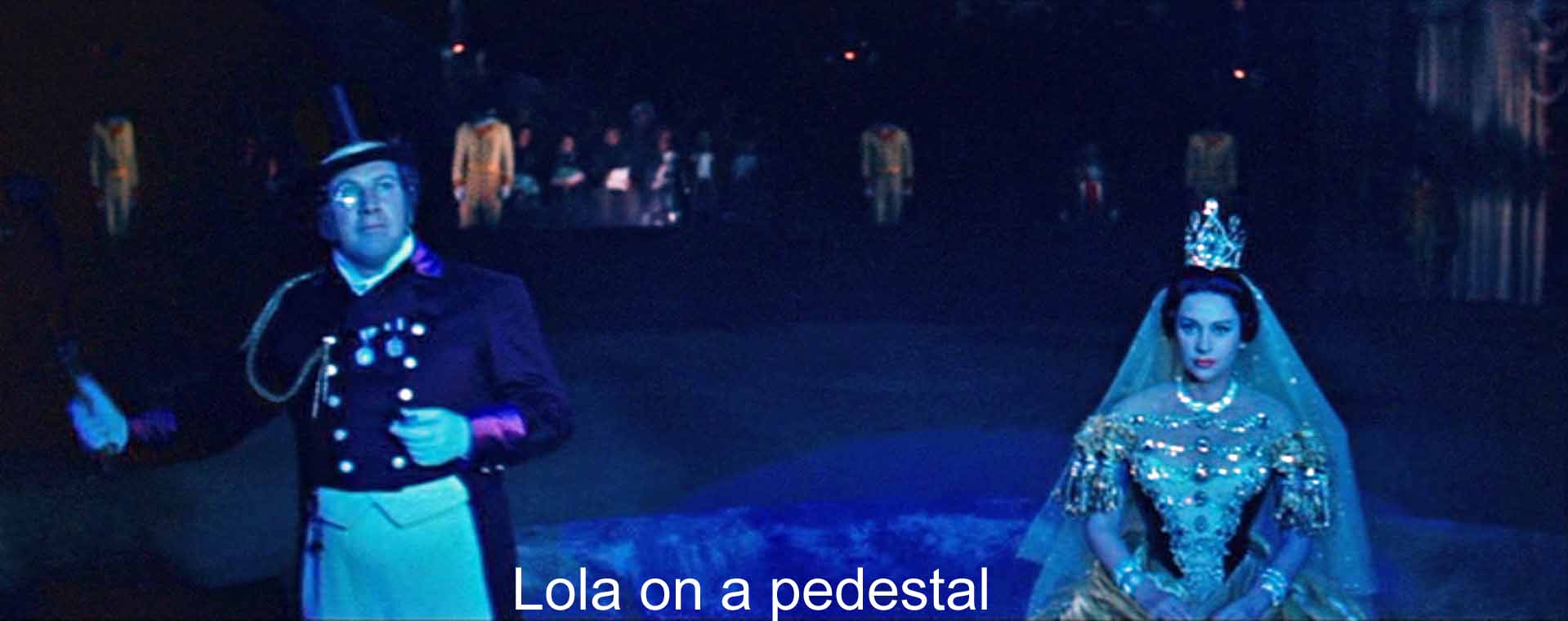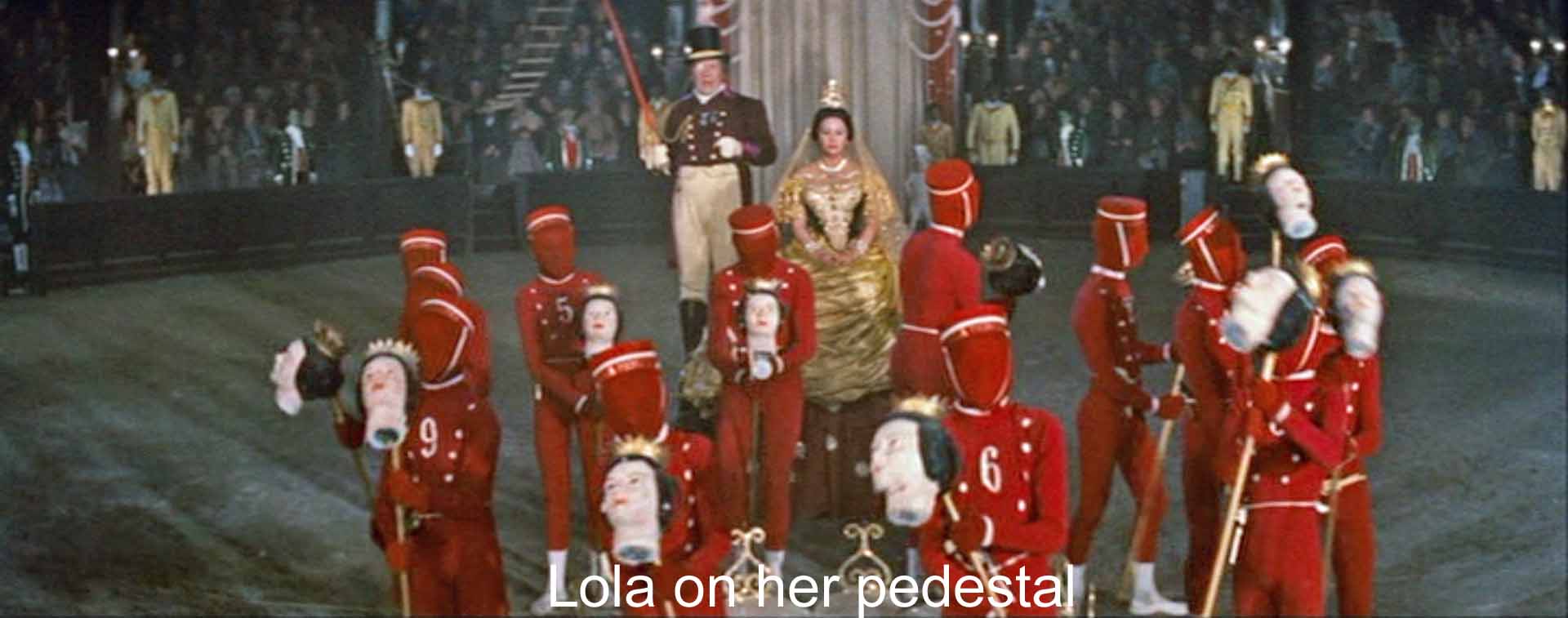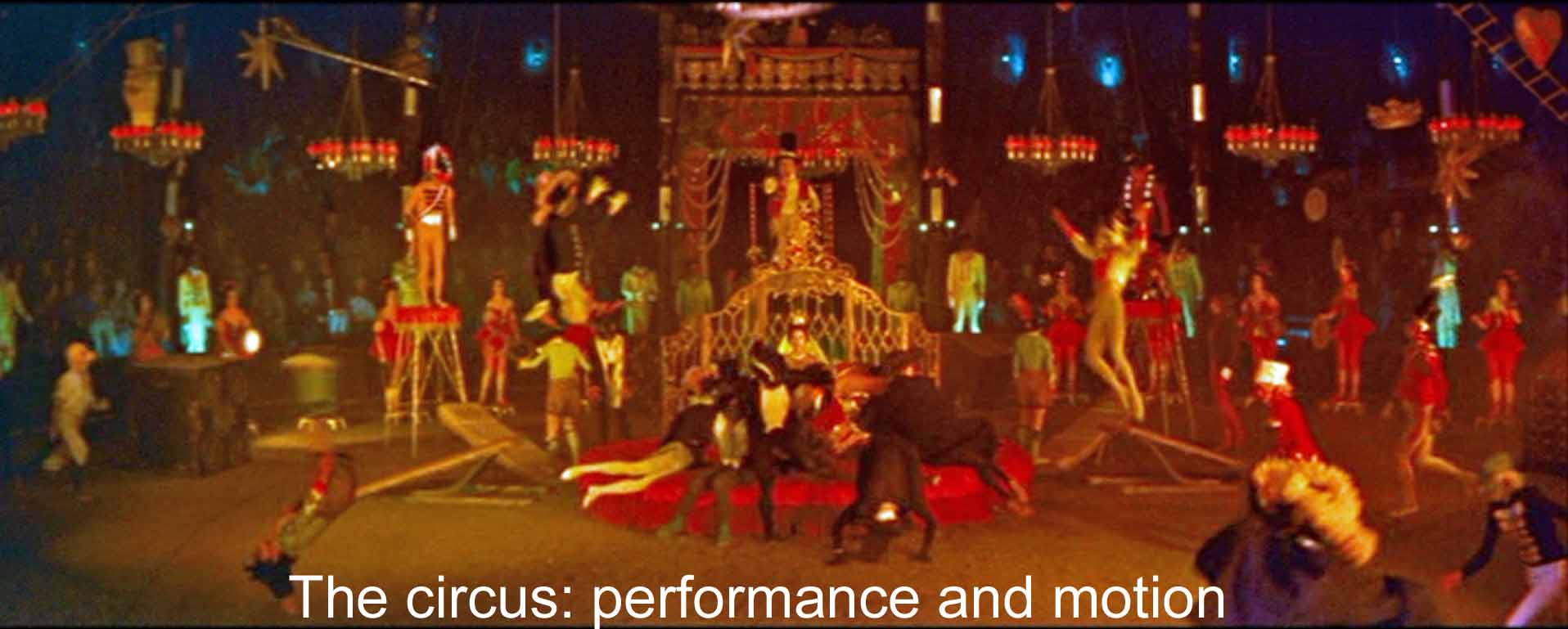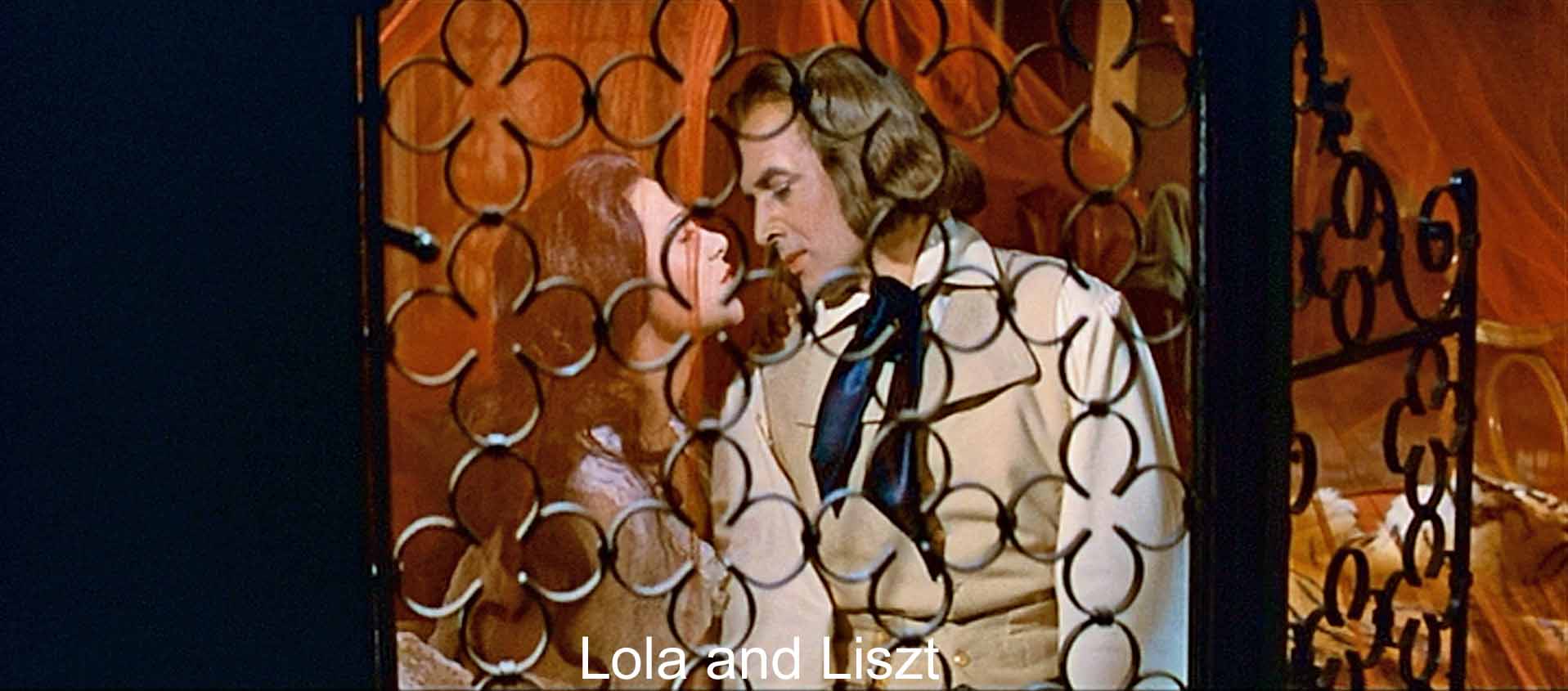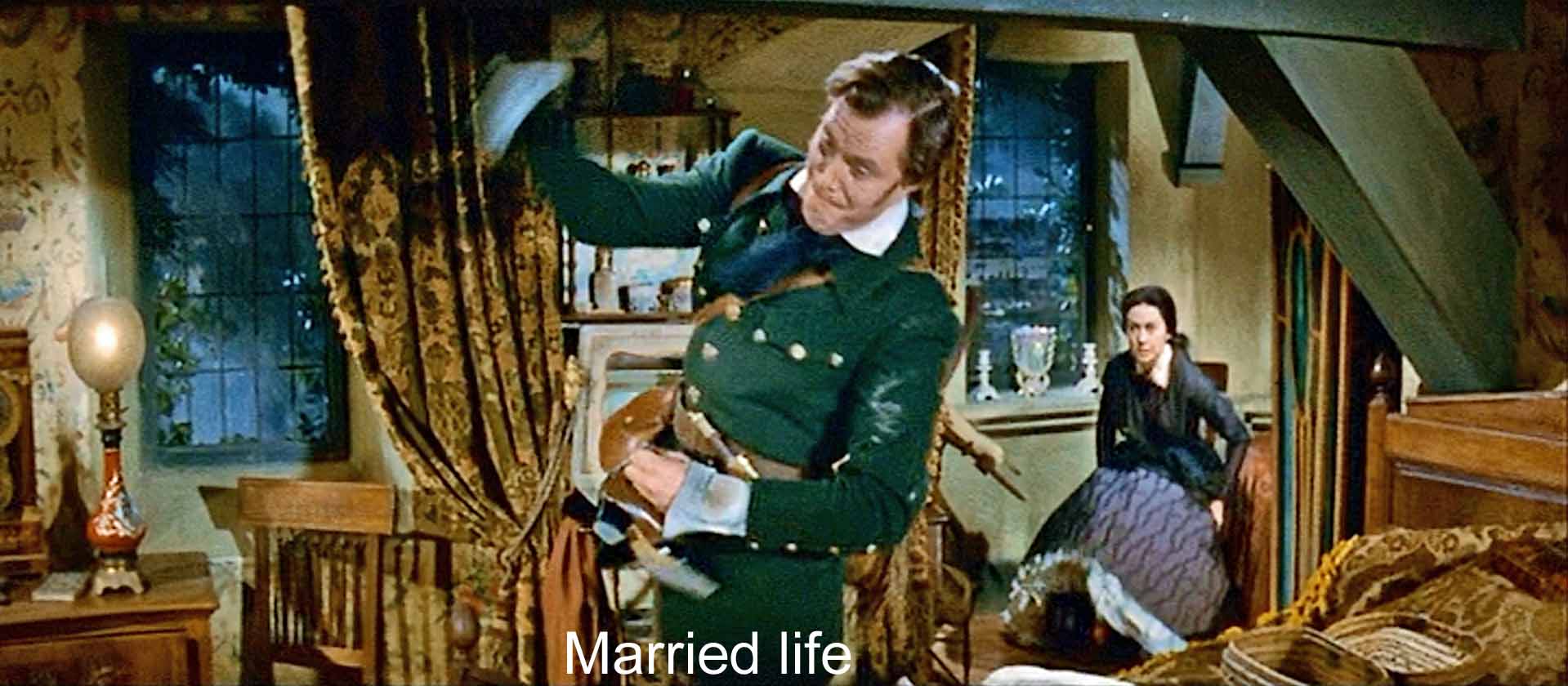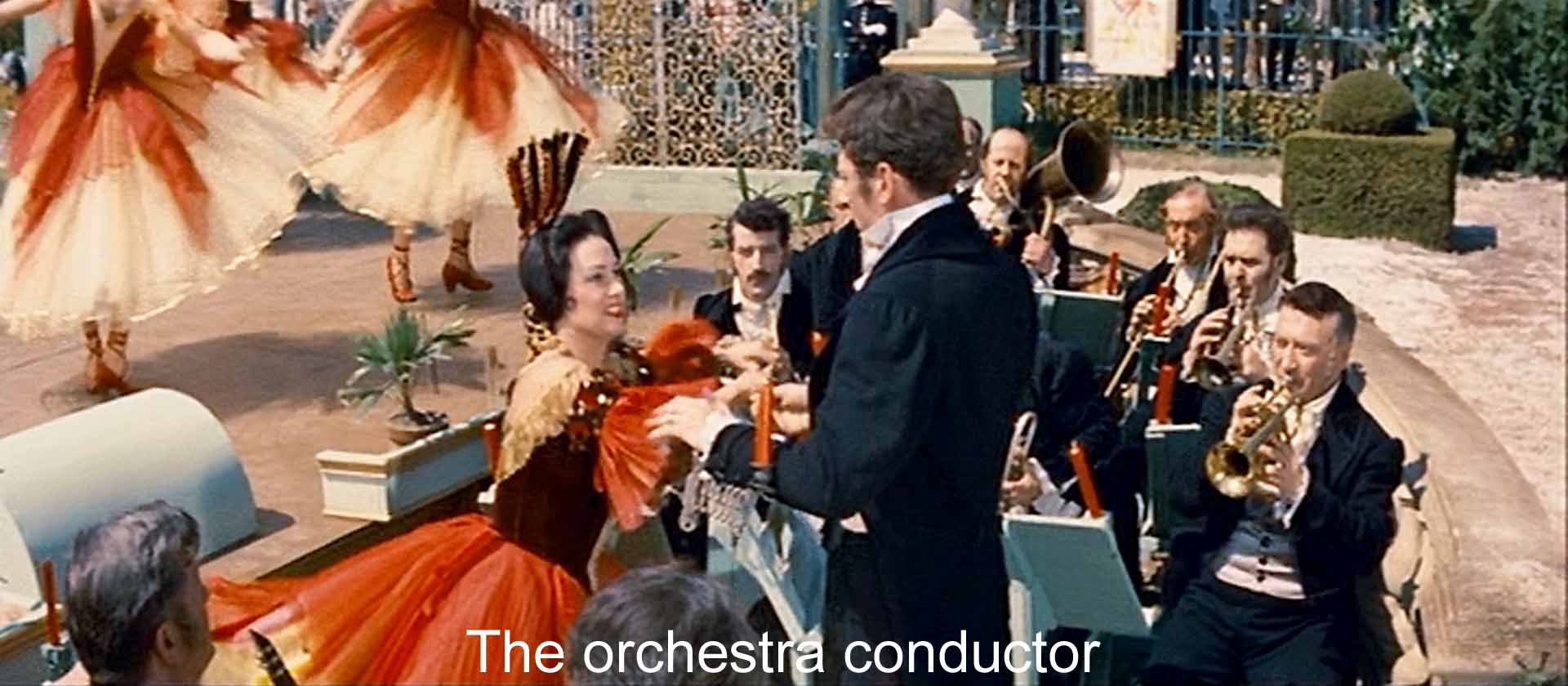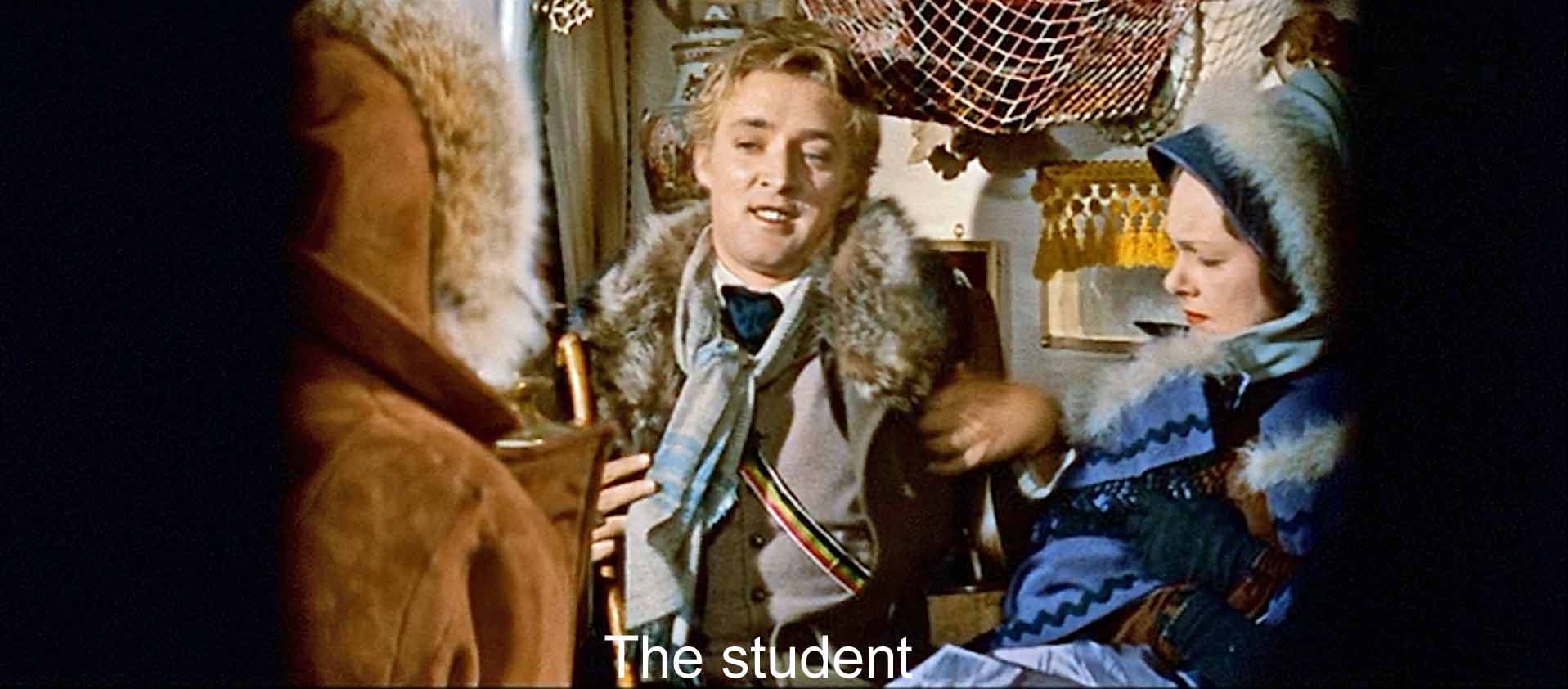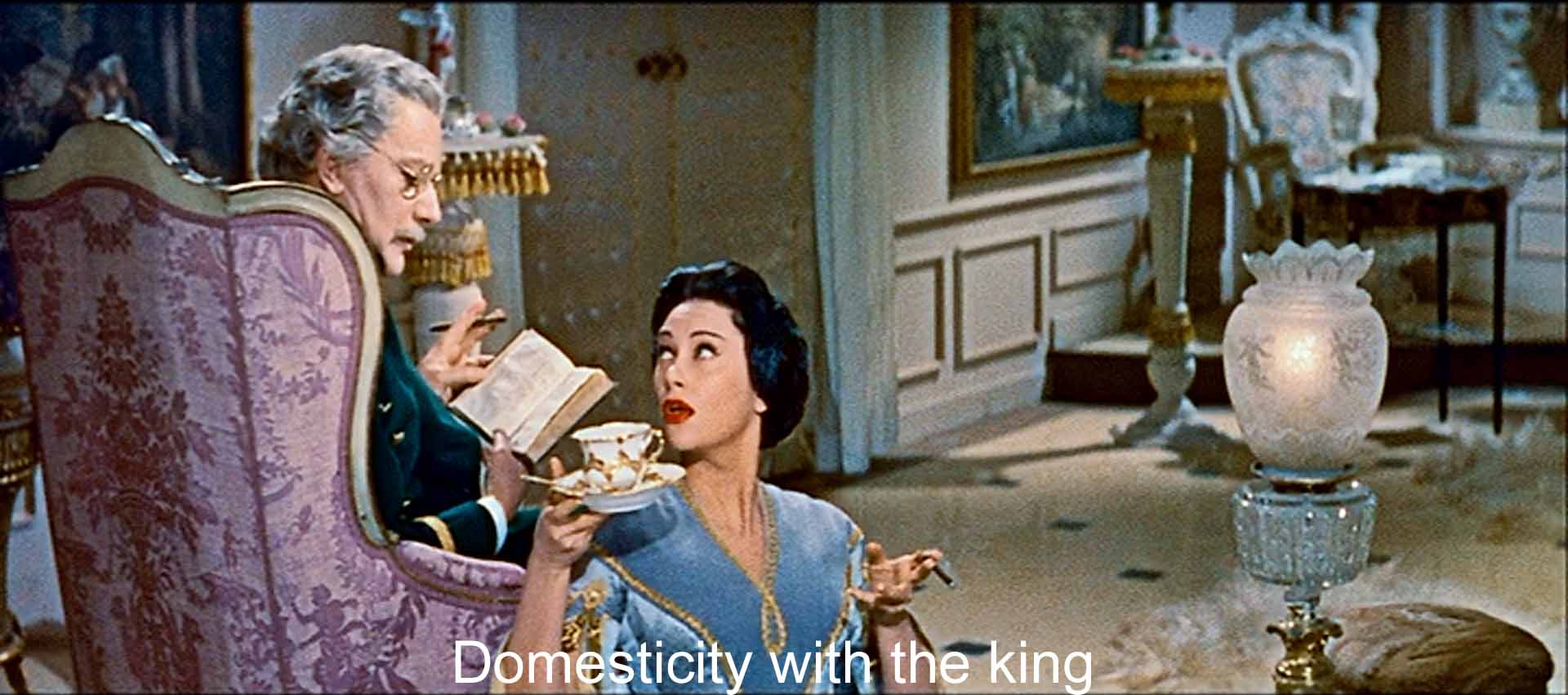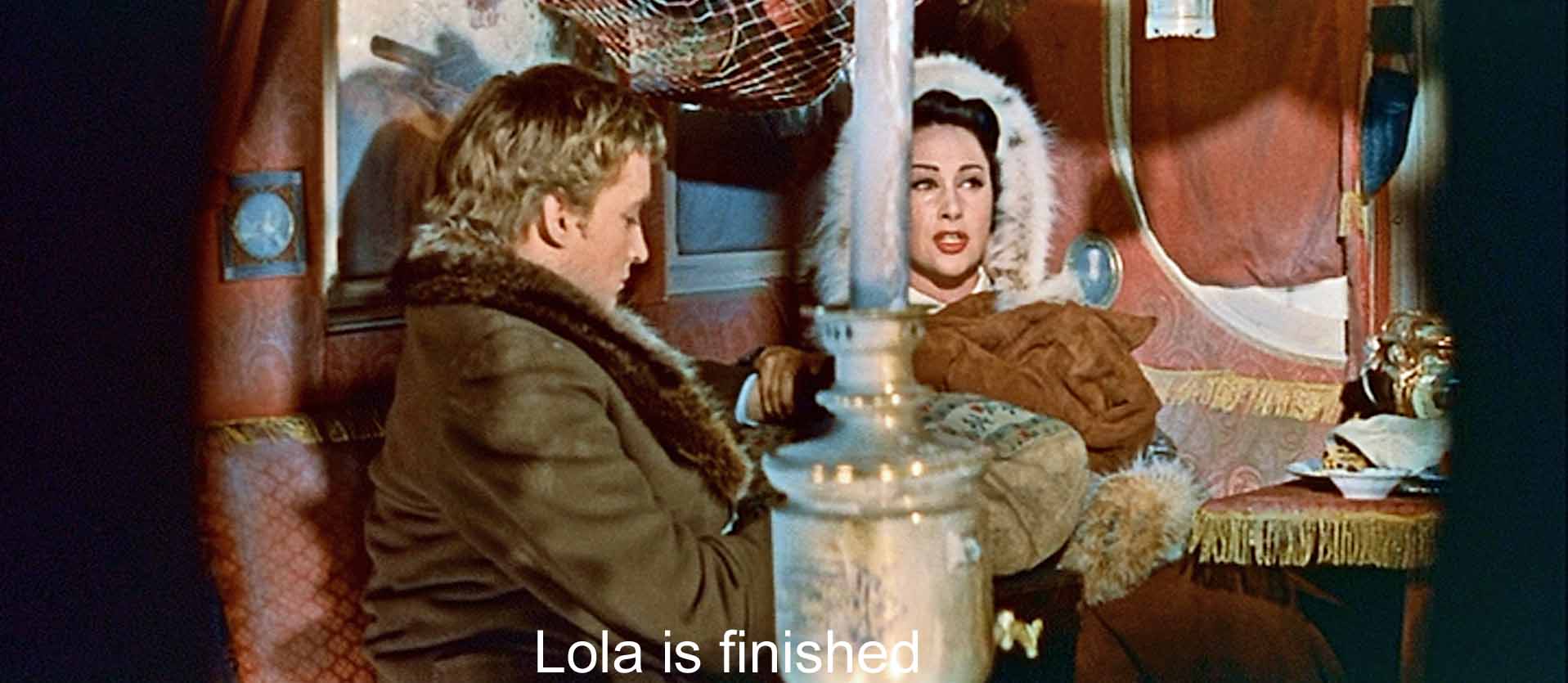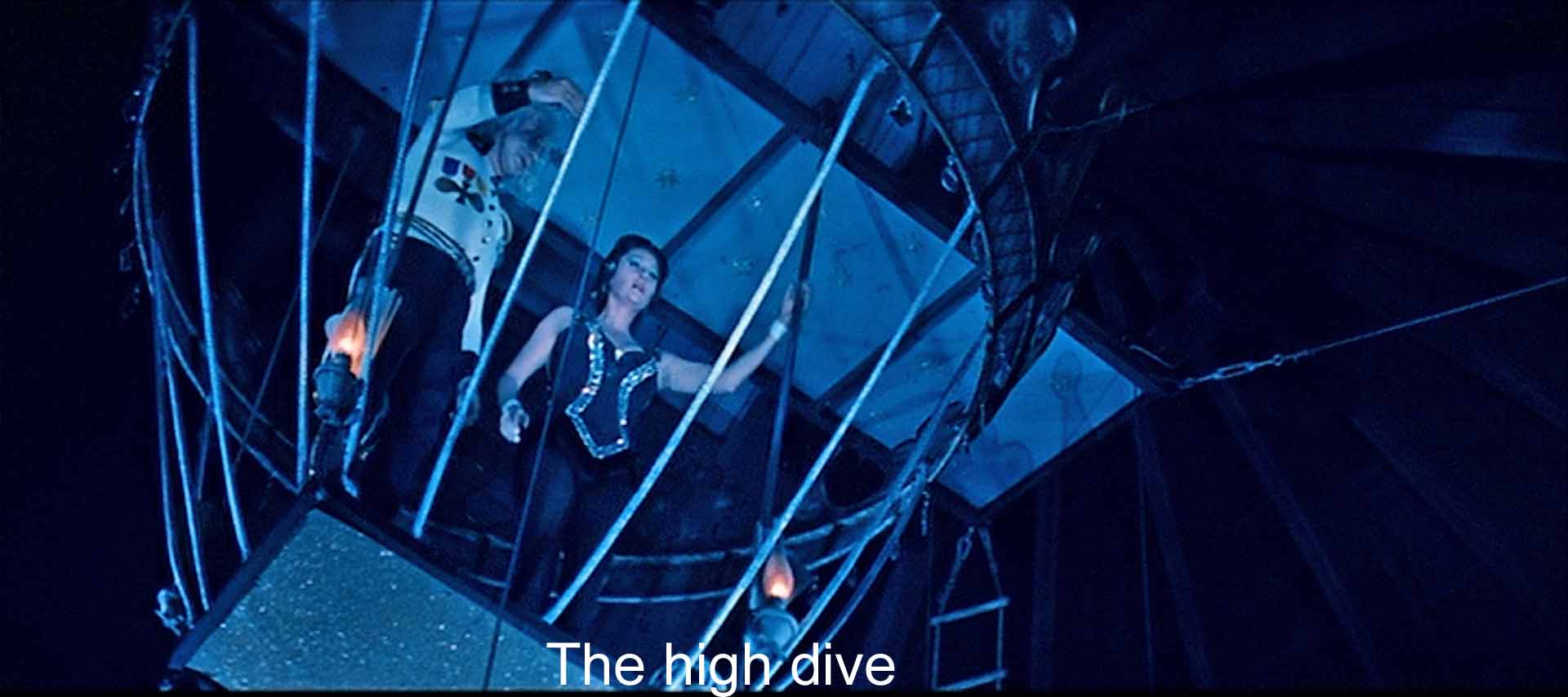You have never seen a biopic like this. The real-life Lola Montès, Eliza Rosanna Gilbert, was born in County Sligo, Ireland, in 1821. Two years later, her father’s regiment was transferred to Calcutta, where he died. Her mother remarried, and the couple sent Eliza to England for schooling, where she distinguished herself by her mischief. She eloped with a Lieutenant James, but the marriage failed. She re-invented herself as “Lola Montez the Spanish Dancer,” appearing in London and across Europe. Quite talentless, she really marketed herself by scandalous affairs she had: notably with Liszt, who initiated her into George Sand’s circle, but also with various rich nobodies and notables. (Think Kardashians.) The affairs peaked with King Ludwig I of Bavaria. She pushed various liberal measures, and outraged conservatives who then deposed the king (among other 1848 revolutions). She narrowly escaped from Munich and continued as a risqué dancer, traveling as far as the goldfields of California and Australia. She never became a circus attraction. Instead, she ended up living a quiet life in Philadelphia and New York, where she worked to help “fallen women.” Dead at 39, she is buried in Brooklyn. The standard biopic would march stolidly through childhood (in India), first marriage, dancing career, affairs, royal romance, final decline, and finish up with after-death praise.
But you have never seen a biopic like this. Ophüls’s Lola is ending her life as an attraction in a New Orleans circus, and as flamboyant a circus as you’re likely to see. The Ringmaster (Peter Ustinov) tells the audience they can ask Lola anything they want about her scandalous life. (This, like everything else the Ringmaster tells us, is not true; he manages the questions.) Lola has become porn.
Ophüls’s best movies tell their story from the point of view of a woman. Here embedding the events of Lola’s life in an imaginary circus lets Ophüls develop men’s (and women’s) fantasies of Woman with a capital W. Woman arouses irresistible sexual desires. Men have only to look at Lola to be captivated. (This fantasy leads to the twisted logic behind the Muslim veiling of women. To prevent men’s sinning sexually, don’t restrain the men; make the women cover up.) In this film, all men are overwhelmed right away by the desires Lola arouses, from a naive and lowly student (Oskar Werner) to a languid king (Anton Walbrook).
She is dangerous. She can even cause the downfall of a king. The Ringmaster tells us right off that she is a “wild beast a hundred times more dangerous than the ones in our menagerie.” She is castrating. She takes from the student his precious fraternity sash, cravat and walking stick from Liszt, the baton from an orchestra conductor on the Riviera, and the cigar from the king, she appropriates the symbols of their masculinity, and then she herself smokes cigars. But she is also weak and fragile. Lola is dying, but men insist that she must do her dangerous dive anyway. She can be soiled as in the talk of “fallen women” symbolized by Lola’s high dive in the circus, but also by all the ugly curiosity (including our own) about her sex life. Woman is Mother, as when Lola tends the king or sets him to reading Hamlet. And Woman exists simply for the pleasure of men. She is an all-powerful goddess as when she sits enthroned and crowned on a pedestal in the circus, surrounded by men who carry her here and there.
This tangle of conflicting fantasies applies to the glamorous woman. But some women are just ordinary, like Lola’s maid Josephine (Paulette Dubost) in her long-term relationship with Lola’s coachman (Henri Guisol). It is the beautiful woman who acquires the powers of a goddess—or a wild beast.
The amazing final scene leaves us with that question. Is Lola in a cage as befits a wild beast? The Ringmaster has said, “She will be in our menagerie among the wild beasts.” Or is she seated in a shrine in which a goddess receives her worshippers (all male)? In Ophüls’s final shot, the camera tracks back for 100 seconds along the long line of men waiting to kiss Lola’s hand for a dollar. Is it she who abases herself or the men? Is she a goddess being adored? Or is she a woman selling her flesh, a mere prostitute? Or is she, as Andrew Sarris wittily suggested, granting absolution to us the audience and all moviegoers for our prurient curiosity?
The camera tracks back between the closing curtains on which are crudely painted the scenes of Lola’s life. The film begins and ends with these curtains. They suggest Lola’s exterior, mere facts. Opening up, they promise to reveal Lola’s interior life. But instead we get the circus, all bright colors and motion and rising and falling performers. In the finale, we get Lola having her hands kissed. Is this part of her interior life or just more show? The curtains close. We won’t know.
As always with Ophüls, he calls attention to the narration, the way he will tell the story. Here, the film exists in two modes. One is the circus, and many a director has used it as a symbol: Bergman, Fellini, Tati, the Marx Bros., Carol Reed, and on and on. A circus is not only rich in symbolic possibilities, it evokes the attitude called for by Bertolt Brecht, watching and judging a performance, not getting identified with the characters.
Ophüls’s circus consists of a madcap crew swinging, tumbling, juggling, running, dancing, riding, climbing, falling, soaring—motion, a major theme in this movie. Lola tells the Ringmaster trying to hire her, “I do as I please.” He in turn wants “power and efficiency.” I think Ophüls’s circus is a metaphor for an anything-goes carnival but within a framework of profit-and-loss. Anything goes, yes, but controlled by the owner disguised as a clown or the Ringmaster. This circus is a capitalist society. Performance for profit
I find two things interesting about the opening circus scenes. One, the circus people move, but Lola does not move. She is carried here and there or turned round and round, but she herself—a dancer after all—does not move. The second thing: the performers, the orchestra and various flunkies are all masked. They either wear masks that cover their faces or they are in blackface or they are made up (like the wrestler). Blackface and the various blacks signal that this is the United States (as does the orchestra’s leader dressed like Uncle Sam), but the Ringmaster addresses the audience in French (but also bits of English and German). This is New Orleans. We see Lola’s face and the Ringmaster’s, but he is faking and she is expressionless. Most curious of all, the bellboys in red use hollow molded heads of Lola on sticks to collect the quarters and dollars from the audience—empty heads for collecting money.
By starting with Liszt, Ophüls set Lola in a group of artistic types who bounced around Europe in the Romantic era, carrying on (and profiting from) scandalous affairs: Liszt, George Sand, Byron, the Shelleys, Chopin, George Eliot, and so on. From the start she is a sexual performer, and that is why the Ringmaster wanted to hire her for his show.
The circus is one mode for Ophüls’s narration. The other is Lola’s recollections, demanded by the Ringmaster for the philistine circus audience. Here Ophüls goes into normal moviemaking mode. And therein lies a paradox, for this mode purports to give us Lola’s memories, but film cannot give us states of mind the way a novel can. Film can only show us the look of things. Film is show—like the circus. Ophüls gives us show within show.
We do get a hint of Lola’s interior life, when Liszt tells her (and the Ringmaster later sings), “You give your body, but you keep your soul.” Lola has a morality that she demonstrates with her rage at the lover who didn’t tell her he was married or her using her final dive to raise money for “fallen women,” or is the Ringmaster faking that?
Critics have complained that Martine Carol’s acting is wooden, but that’s as it should be. Lola has an interior life, and we see it when she jumps up to tell Liszt how to play his music for dancers or when she tells the Ringmaster who has just kissed her, “Don’t be a fool like all the others.” She is strong-willed. She snatches mother’s boyfriend. She gallops her horse through a column of soldiers. She tears open her bodice to impress the king. When Lola moves, she is being herself, her real self. The rest of the time she is reserved—wooden, if you will.. She is a professional, and she respects the three men who treat her as a professional: Liszt, the Ringmaster, and to some extent the king. He at least pretends to take her seriously as a dancer, and she in turn insists, when the revolt breaks out, that he must play his part as a king. He too is a performer. He has to move, and he does.
Directing them all, Ophüls himself performs—moves. His hand is everywhere in this film. As always his camera is circling and tracking and craning up and down. His set has staircases again and again. Movement up and down marks Lola’s gaining or losing status.
This is Ophüls’ only movie in color and he has managed the color schemes exquisitely. Bright primaries, red, yellow, and blue in the circus scenes; autumnal colors in the Liszt episode as befits the end of an affair; white for the scenes in Bavaria beginning with snow and going on to the creamy walls of the palace rooms. The film ends with dun colors for the men filing up to kiss Lola’s hand for a dollar, the drab ending of Lola’s show.
Friends and biographers tell us that Ophüls didn’t really approve of show. He felt there was something immoral in people’s paying to see other people’s emotions or talents. That objection wouldn’t apply to a camera’s performance, and perhaps that’s a reason Ophüls is so wedded to the moving camera.
For Ophüls the Ringmaster’s turning Lola’s into a circus attraction meant that he shamed and degraded her. And this is symbolized by her dangerous (and degrading) dive in the last moments of her performance. She is literally and ironically a “fallen woman.”
Incidentally, the real Lola never performed in a circus. This is Ophüls’s way of disapproving of her showbiz lifestyle—as well as exploring the idea of performance. In the opening shot, chandeliers descend to open a show. Downward movement stands for Lola’s fall from the heights of celebrity, as the Ringmaster says, “from kingdom to carnival.” And, in the best tradition of advertising or public relations, everything he says is spin and trickery.
In the Liszt episode, the first flashback, Lola tells us that life is for her movement. “La vie pour moi c’est un mouvement.” And Ophüls himself said much the same thing: movement is the sign of life. That’s probably another reason he was so committed to the moving camera. In this film he does complicated things with motion.
The first thing we see is chandeliers descending (foreshadowing Lola’s descent from “kingdom to carnival”). Then there are the circus flunkies performing every kind of motion one can imagine while Lola herself is still, moved but unmoving. She cries when her mother dances on board ship, and she is not allowed to. She runs away from her husband. She becomes a dancer.
Talking to Liszt, she runs across the frame to tell him how to play his music for dancers. The circus shows her training to be a dancer then going in a rapid sequence from the Russian ambassador (masked Cossacks) to the French ambassador to a sultan in Istanbul to a church in Ragusa to a wrestler in Budapest . . . . (This focus on performance explains a tiny detail. The particular passage from Hamlet that Lola has the king read performs his world-weariness.) Lola is most herself when she is in motion, when she is dancing for the king or tearing her bodice open or escaping from the palace or—think about it—when she is taking her dangerous fall. Lola in motion is the real Lola, not the Lola on a pedestal or in a shrine at the circus. Motion is life, even for the performers in the circus. And because performance for Lola and for the circus people involves motion, performance itself becomes life and life performance.
Ophüls’ performance was directing movies, movies in which humans define themselves by their performances. Stefan in Letter from an Unknown Woman (1948), the characters directed by the meneur de jeu in La Ronde (1950), the dancer, the model, and the prostitutes in Le Plaisir (1952), all perform. All make crucial movements as Lola does in this film. What started out as a simple biopic becomes through Ophüls’s flowing camera work a complex fable involving our fantasies of Woman, the nature of narration, and movement as defining both performance and life. Lola Montès is one of the most intricate films in the canon of great movies.


